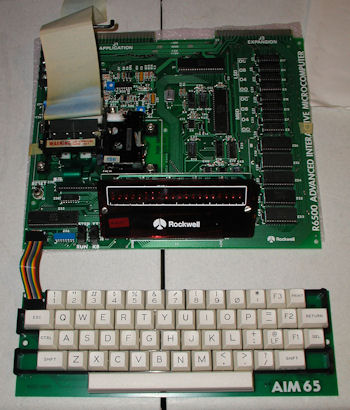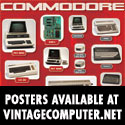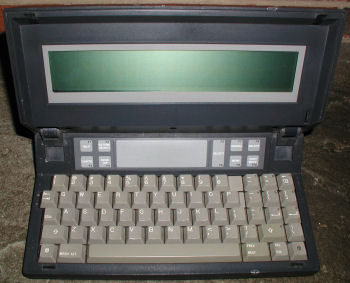Rockwell R6500 (AIM 65)
SHARE |
|
  Rockwell R6500 (AIM 65)
Rockwell R6500 (AIM 65) |
by Bill Degnan - 09/12/2011 20:04 |
 The Rockwell model R6500 was better known as the AIM 65. The AIM 65 is a 6502-based single board computer from 1976, although the model remained popular through the early 1980's until it was eventually replaced by the AIM 65/40.
AIM stands for "Advanced Interactive Microcomputer" and the 65 most likely is a reference to the 6502 processor and related chips. Right? I have two AIM 65 systems, one was fresh out of the box and never used. I am doing my experimenting with the used unit. I also have a 8-slot card cage containing a general purpose module, Serial card, disk controller, and video controller. The system boots to the system monitor and then I can jump to BASIC. I have run some assembly programs and some BASIC programs. Pictures I have a card cage with backplane, so that I can use the CRT card and view screen output to something better than the little one-line LCD. Need to read up on this first. Reply |
|
  AIM 65 Getting Started
AIM 65 Getting Started |
by Bill Degnan - 09/29/2011 09:44 |
|
AIM 65 Starter Guide
To operate a bare-bones AIM 65 one needs only to send power to the 5V and attach the associated GND line next to it. The printer requires 24V, but a powered printer is not required for the system to function. The board itself has no on-off switch. To turn on the computer attach the power lines and activate the power supply. The SBC is wired to load the ROM monitor when power is applied to the system. If the printer was left unpowered, the LCD screen will report a "PRINTER DOWN" error message, otherwise the system will flash the AIM 65 welcome screen followed by the system prompt " > ". Keyboard Hopefully the AIM 65 keyboard and cable came with your system as this is the means one interacts with the computer. The cable is stright-through so you can attach either way. Loading BASIC If you press 5 the system monitor will load BASIC. Hit [return] to accept default values when asked about memory and screen width. The total RAM available should be greater than 7000 bytes, I don't remember the exact number off hand. Here are a few useful ROM monitor commands: M [return] - display memory M 0200 [return] = show me the values currently stored in 0200, 0201, 0202, 0203. [space] = while in display memory mode, show me the next four values. Memory Map Write programs that start at 0200 BASIC starts at 6000 The monitor starts at ECA2 (I believe) The monitor uses 0000 - 01FF for keeping track of things. 1 page of ram is 256 bytes. i.e. C600 - C6FF Entering Programs / Updating RAM / [return] - I wish to be able to change memory at the current program counter location /200 [return] - I wish to change memory at 0200 The system will display the memory location and position the prompt for entry of a new memory value. Enter the HEX value and the prompt will jump to the next location. If no change is needed, hit the space bar to move to the next address. Enter values or hit the space bar to get to the end of the 4-address line. If you want to edit the RAM in the next memory address location, press /. Running a Program * 200 [return] = load 0200 as the program counter G [return] = run program from program counter (0200) E.g. * 6000 [return] G [return] (this should start BASIC) Mnemonic Entry (assembler) I [return] = begin loading using Mnemonic entry at wherever the program counter is now I * 200 [return] begin loading at 0200H. e.g LDA40 (space) = enter load command and jump to next line STA41 (space) BRK (esc) = load break line and ESC to exit. Wiring System for Cassette The tape lines plug into the application port Get a 22/44 connector with .156 spacing to attach to the application port so you can wire up the computer to a cassette player. Pin 1 = ground Pin L = Tape In (this is the 10th pin from the left on the bottom row) Pin M = Tape Out (this is the 11th pin from the left on the bottom row) Printer Use the correct type of thermal paper. Activate the printer especially when doing a lot of coding in mnemonic assembly. To toggle on/off the printer use CTRL + PRINT from the keyboard. A good Sample Program - The AIM Clock http://vintagecomputer.n...cro_Mar79_AIM_clock.pdf NOTE: There is an error in the program listing. 0305 should be F8 not 38! Otherwise there will be 16 seconds for every 10 second cycle! (Thanks Mike for helping me debug this) Let me know if you have other questions. Reply |
|
  Video from the VCFMW 2011
Video from the VCFMW 2011 |
by Bill Degnan - 10/18/2011 23:44 |
|
http://www.youtube.com/watch?v=rzAoTibN-1s AIM 65 Running a clock program. Reply |
|
  RM65 FDC
RM65 FDC |
by David Colglazier - 12/26/2011 12:03 |
|
Hi Bill, I am trying to get a copy of the RM65-7101 FDC user manual...any chance you know where it is online? Reply |
|
  RM65-7101 FDC user manual
RM65-7101 FDC user manual |
by Bill Degnan - 12/26/2011 15:19 |
|
David, I only have the original manual, I was not able to find any references to this online either. Reply |
|
  scan document-read next reply!!!
scan document-read next reply!!! |
by David Colglazier - 12/26/2011 17:46 |
|
Would you be willing to remove the staples and scan the document and
post it online? If you can't post it here, I'll get it posted if you send it to me hopefully in pdf format. Reply |
|
  RM65 FDC
RM65 FDC |
by David Colglazier - 12/27/2011 18:31 |
|
Hi Bill, I was going through my PL-65 manuals and found the FDC user's manual REV. 1, June 1982 so I will break mine apart and do the scanning. Do you want a copy and if so, I will send you a link to my site to pick it off. Sorry for the time spent but at least I got to find out you know Jack Rubin. Dave Reply |
|
  Cassette Signal Issue
Cassette Signal Issue |
by Bill Degnan - 07/21/2018 11:07 |
|
Juergen writes:
> > VintageComputer.net Inquiry Contact Information Name: CMGB > Email: cmuseumgb- at -gmaildot com Comments: > In regards to blog post titled Rockwell R6500 (AIM 65): > I am one of the founders of the Computer Museum in Basel (CMBB/CMGB). We have 2 AIM 65 units that seem functional. However, we're experiencing problems with the cassette drive when trying to read back. We tried to record using cassette recorders and also a modern PC through line in and the audio signals are clearly recognizable (from pin M). A connection to pin L and using the corrected program to test readback from "micro_11_apr_1979_text_syn_read_program_AIM65.pdf" only displays the "N" on either AIM 65 system. The cassette interface potentiometers are sealed in one of the units by the manufacturer and have never been changed as far as we can tell. Is there anything we could try to get reading from tape to work? We are running our of ideas. Is there any way to visualize the incoming signal through a small program other than the one from the magazine? > > Kind regards from Basel > > Juergen > My reply: My first thought is that the power isn't right, the cassette needs an extra line I believe 12V, but I have to check. I have these notes: Corrections to Guide which talks about the cassette test routine being in error. I assume the PDF you're referencing corrects this. I don't know where micro_11_apr_1979_text_syn_read_program_AIM65.pdf is located (on this site?) so I will have to consult an original copy of the magazine and get back to you. Reply |
|
Resources:

Popular Topics and FAQs
Past Issues:
Before we switched over to a blog format, past page archives here:
Vintage Computer Festival East 3.0 June 2006
Commodore B Series Prototypes July 2006
VOLSCAN - The first desktop computer with a GUI? Oct 2006
ROBOTS! - Will Robots Take Over? Nov 2006
Magnavox Mystery - a Computer, or? Jan 2007
The 1973 Williams Paddle Ball Arcade Computer Game Feb 2007
The Sperry UNIVAC 1219 Military Computer May 2007
VCF East 2007 - PET 30th Anniversary June/July 2007
The Electronic Brain August 2007
Community Memory and The People's Computer Company October 2007
Charles Babbage's Calculating Machine December 2007
Vintage Computing - A 1983 Perspective February 2008
Laptops and Portables May 2008
From Giant Brains to Hobby Computers - 1957 to 1977 August 2008
Historic Computer Magazines November 2008
World's Smallest Electronic Brain - Simon (1950) December 2008 - Feb 2009
Free Program Listings Spring 2009
Computer Music Summer 2009
Popular Electronics Jan/Feb 1975 - Altair 8800 Fall 2009
Early Microcomputer Mass Storage Summer 2010
Gavilan SC

This image was selected at random from the archive. Click image for more photos and files from this set.